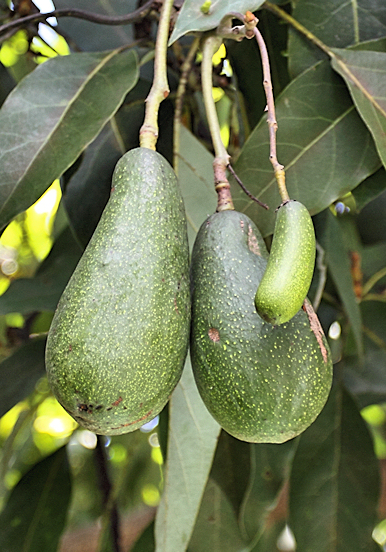Avocado
Avocado is the vernacular name applied to the tall, evergreen trees of the species Persea americana, as well as to their fruit. Avocado, which is of Central-American provenance, is nowadays grown in all subtropical and tropical regions of the world. There are three main groups (or races) of cultivars: Mexican, Guatamalan and West Indian, which may, respectively, be regarded as subtropical, semi-tropical and tropical. The Mexican cultivars are relatively cold tolerant and bear small fruits with a thin skin and high oil content. The Guatamalan cultivars are moderately cold tolerant and bear variably-sized fruits, with a warty skin and medium oil content. The West Indian cultivars have no cold tolerance; bear variably-sized fruits with a leathery skin and low oil content. This wide range in tolerances for climatic conditions allows avocado to be cultivated between latitudes 40º north and 40º south.
Avocado trees blossom in the spring in large inflorescences whose complete flowers open twice, first functioning as females, than as males. While this precludes self-pollination, it necessitates the planting of more than a single cultivar in a plantation, in order to obtain good fertilization. The fruit is large, oblong and pear-like, an edible berry covered by a green skin and has a single stone. Seedless, unfertilized fruit are cucumber-like (“cukes”) and may remain on the trees more than the normal fruit. Common cultivars are Ettinger (mostly Mexican), Fuerte (Mexican and Guatamalan hybrids), Haas (mostly Guatamalan) and Nabal (Guatamalan). Avocado has been called the most nutritious of all fruits.
World production of avocadoes came to about 2,700,000 tons in the year 2002, mostly produced on the American continent: North and Central America contribute approximately 60% (most in Mexico), South America produces another 20%; the reminder by the rest of the world.
The dominant cultivar is Hass. The European Union is the most important market for avocadoes and in 1987 it was dominated by imports from Israel. It is estimated that after the year 2004 Israel, with about 5,000 hectares planted to avocado, will annually export over 50,000 tons to the EU.
Research on avocado is summed up in periodical international congresses that are published as Proceedings. In addition, The California Avocado Society produces an annual yearbook that may be accessed at the site http://www.avocadosource.com/CAS_Yearbooks/CAS_Yearbooks.htm.
Major avocado pests in the Middle East
References
Anonymous, 2003. FAO Production Yearbook for 2002, # 56. FAO, Rome, Italy.
Anonymous, 2003. Statistical Abstract of Israel, # 54. Central Bureau of Statistics, Jerusalem.
Swirski, E., Wysoki, M. and Izhar, Y. 1995. Avocado pests in Israel. Proceedings of the III World Avocado Congress, pp. 419–428.
Whiley, A.W., Schaffer, B. and Wolstenholme, B. N. 2002. The Avocado: Botany, Production and Uses. CABI Publishing, Wallingford.
Websites:
http://www.crfg.org/pubs/ff/avocado.html
http://images.google.com/images?hl=en&lr=&ie=UTF-8&oe=UTF-8&q=+Avocado+&sa=N&tab=wi

